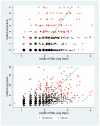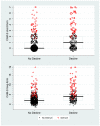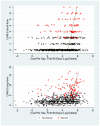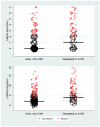The CAM-S: development and validation of a new scoring system for delirium severity in 2 cohorts
- PMID: 24733193
- PMCID: PMC4038434
- DOI: 10.7326/M13-1927
The CAM-S: development and validation of a new scoring system for delirium severity in 2 cohorts
Abstract
Background: Quantifying the severity of delirium is essential to advancing clinical care by improved understanding of delirium effect, prognosis, pathophysiology, and response to treatment.
Objective: To develop and validate a new delirium severity measure (CAM-S) based on the Confusion Assessment Method.
Design: Validation analysis in 2 independent cohorts.
Setting: Three academic medical centers.
Patients: The first cohort included 300 patients aged 70 years or older scheduled for major surgery. The second included 919 medical patients aged 70 years or older.
Measurements: A 4-item short form and a 10-item long form were developed. Association of the maximum CAM-S score during hospitalization with hospital and posthospital outcomes related to delirium was evaluated.
Results: Representative results included adjusted mean length of stay, which increased across levels of short-form severity from 6.5 days (95% CI, 6.2 to 6.9 days) to 12.7 days (CI, 11.2 to 14.3 days) (P for trend < 0.001) and across levels of long-form severity from 5.6 days (CI, 5.1 to 6.1 days) to 11.9 days (CI, 10.8 to 12.9 days) (P for trend < 0.001). Representative results for the composite outcome of adjusted relative risk of death or nursing home residence at 90 days increased progressively across levels of short-form severity from 1.0 (referent) to 2.5 (CI, 1.9 to 3.3) (P for trend < 0.001) and across levels of long-form severity from 1.0 (referent) to 2.5 (CI, 1.6 to 3.7) (P for trend < 0.001).
Limitation: Data on clinical outcomes were measured in an older data set limited to patients aged 70 years or older.
Conclusion: The CAM-S provides a new delirium severity measure with strong psychometric properties and strong associations with important clinical outcomes.
Primary funding source: National Institute on Aging.
Figures










Comment in
-
Delirium severity in the hospitalized patient: time to pay attention.Ann Intern Med. 2014 Apr 15;160(8):574-5. doi: 10.7326/M14-0553. Ann Intern Med. 2014. PMID: 24733202 Free PMC article. No abstract available.
References
-
- Inouye SK, Westendorp RG, Saczynski JS. Delirium in elderly people. Lancet. 2013 Epub ahead of print. [PMID: 23992774]
-
- National Institute for Health and Clinical Excellence . Delirium: diagnosis, prevention and management. CG103. National Institute for Health and Clinical Excellence; London: 2010.
-
- Inouye SK. Delirium in older persons. N Engl J Med. 2006;354:1157–65. PMID: 16540616. - PubMed
-
- Witlox J, Eurelings LS, de Jonghe JF, Kalisvaart KJ, Eikelenboom P, van Gool WA. Delirium in elderly patients and the risk of postdischarge mortality, institutionalization, and dementia: a meta-analysis. JAMA. 2010;304:443–51. PMID: 20664045. - PubMed
Publication types
MeSH terms
Grants and funding
LinkOut - more resources
Full Text Sources
Other Literature Sources
Medical
